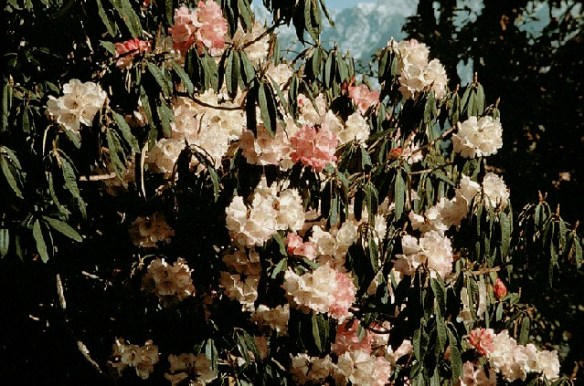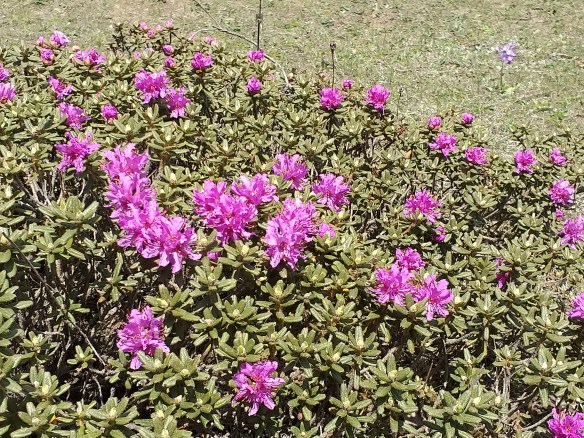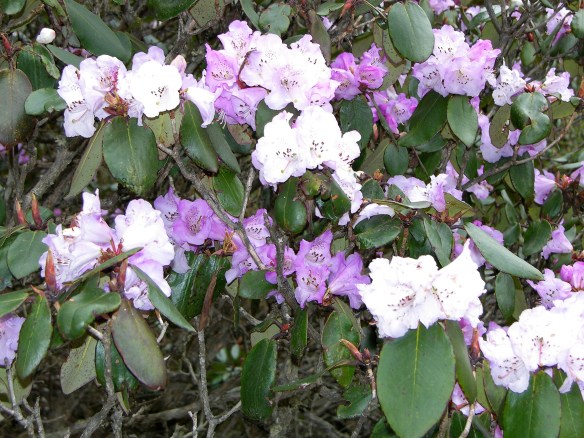 Here in ‘loose down’ Kathmandu in the spring of 2020, I wonder when spring plans for a trip back to Khumbu might materialize.
Here in ‘loose down’ Kathmandu in the spring of 2020, I wonder when spring plans for a trip back to Khumbu might materialize.
The monsoon has arrived lush and humid with the spring rush of flowers fading into numerous shades of green. 
 The monsoon rains create a sudden rush of plant growth in Nepal’s Himalaya, with different species coming into flower each week. Spring and summer in the mountains offer glorious floral displays.
The monsoon rains create a sudden rush of plant growth in Nepal’s Himalaya, with different species coming into flower each week. Spring and summer in the mountains offer glorious floral displays.
Spring in the Everest area brings out purple irises and primroses in open sunny places. The large solitary flower of the iris appears first, days before the leaves come out of the soil. New leaves on the birch trees give the forests a faint sheen of green.
 Nepal is of course famous for the spring blooming of its rhododendrons, the national flower. Whole forests may be in flower at this time. These trees that are usually only waist-high in other parts of the world, may grow ten metres high in the forests of Nepal.
Nepal is of course famous for the spring blooming of its rhododendrons, the national flower. Whole forests may be in flower at this time. These trees that are usually only waist-high in other parts of the world, may grow ten metres high in the forests of Nepal.
 Starting in March, rhododendrons at the relatively lower elevations bring forth bright red clusters of flowers covering the tree. Through April and May, trees at higher elevations come into bloom. The colour of the rhododendron blooms varies depending on which of the thirty species of rhododendron trees is growing at each location.
Starting in March, rhododendrons at the relatively lower elevations bring forth bright red clusters of flowers covering the tree. Through April and May, trees at higher elevations come into bloom. The colour of the rhododendron blooms varies depending on which of the thirty species of rhododendron trees is growing at each location.
 On the higher ridge tops at about 3200 meters, the flowers are pink, or white edged with red. Higher still, the trees are shorter and in June, loaded with soft yellow blossoms.
On the higher ridge tops at about 3200 meters, the flowers are pink, or white edged with red. Higher still, the trees are shorter and in June, loaded with soft yellow blossoms.
 It’s not until July that the short, shrubby rhododendrons in the high meadows flower. Their pale purples color the dwarf, knee high forests of rhododendron, juniper, willow and cotoneaster at 4500 meters.
It’s not until July that the short, shrubby rhododendrons in the high meadows flower. Their pale purples color the dwarf, knee high forests of rhododendron, juniper, willow and cotoneaster at 4500 meters.

 Sheltered beneath these miniature forests are species of geraniums, anemones, forget-me-nots and more primroses. Tall, yellow Sikkimese Primroses abound in wet areas beside streams.
Sheltered beneath these miniature forests are species of geraniums, anemones, forget-me-nots and more primroses. Tall, yellow Sikkimese Primroses abound in wet areas beside streams.
 Higher up on the ridge are dwarfed versions of familiar flowers such as gentians, vetches and saxifrages. The saxifrages specialize in filling in the rocky niches that are uninhabitable for other plants. The name comes from the Greek “sax” for rock and “frage”, to break; saxifrages are rock-breakers despite their delicate appearance in this harsh environment.
Higher up on the ridge are dwarfed versions of familiar flowers such as gentians, vetches and saxifrages. The saxifrages specialize in filling in the rocky niches that are uninhabitable for other plants. The name comes from the Greek “sax” for rock and “frage”, to break; saxifrages are rock-breakers despite their delicate appearance in this harsh environment.
 Many plants flourish in these demanding conditions through adaptations such as leathery leaves, hairiness, compact mat or cushion shapes, and an ability to blossom and form seeds quickly in the short growing season.
Many plants flourish in these demanding conditions through adaptations such as leathery leaves, hairiness, compact mat or cushion shapes, and an ability to blossom and form seeds quickly in the short growing season.
 Some fleabanes grow tall and are cut for hay in the yak pastures but 800 m higher, at the edge of glaciers, closely related plants grow as tight, compact cushions.
Some fleabanes grow tall and are cut for hay in the yak pastures but 800 m higher, at the edge of glaciers, closely related plants grow as tight, compact cushions.
 The harshness of dry winds and temperature extremes is softened by the fuzz covering the edelweiss and pussy-toes that lay low among the rocks. Several kinds of edelweiss thrive in the Everest area, from the villages at 3500 meters right up to the edge of the Khumbu Glacier.
The harshness of dry winds and temperature extremes is softened by the fuzz covering the edelweiss and pussy-toes that lay low among the rocks. Several kinds of edelweiss thrive in the Everest area, from the villages at 3500 meters right up to the edge of the Khumbu Glacier.
The bright blue of one of the most beautiful Himalayan plants is only found up high, close to the blue ice of the glaciers. The Blue Poppy is armed on its leaves and stems with stiff spikes that would discourage any hungry yak from devouring it.
From the hills vibrant with color to the mountains sparkling with fresh snow, the monsoon months offer a spectacle for those braving the mists and the rain.



Wonderful. Thank you dear Frances
LikeLike
What a lovely journey! Thank you.
LikeLike